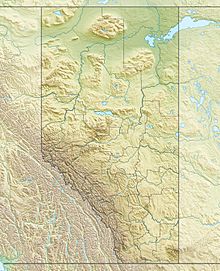Mountain Lake cluster facts for kids
The Mountain Lake cluster is made of two special rock formations in Northern Alberta, Canada. These formations are called diatremes or volcanic pipes. Think of them like old, deep channels that once brought volcanic material up from inside the Earth. They formed a very long time ago, during the Late Cretaceous period, when there was a lot of volcanic activity.
Scientists first thought these rocks were a type called kimberlite, which can sometimes contain diamonds. But later, they reclassified them. Now, they are seen as different kinds of ultramafic volcanic rocks. It's hard to know exactly what they are because much of their original rock material has changed over time into clay.
Where are the Mountain Lake Pipes?
The Mountain Lake pipes are part of a larger area in Northern Alberta known for its kimberlite rocks. This area also includes the Birch Mountains kimberlite field and the Buffalo Head Hills kimberlite field.
These pipes were found in 1989-1990, just north of Mountain Lake. This lake is about 75 km (47 mi) northeast of Grande Prairie, Alberta. The southern pipe is quite large, measuring about 400 m (1,300 ft) by 650 m (2,130 ft). It covers an area of 29 hectares (72 acres). The northern pipe is a bit smaller, about 250 m (820 ft) by 350 m (1,150 ft), covering 8.75 ha (21.6 acres).
These pipes formed within layers of sedimentary rocks called the Wapiti Formation. When they erupted, the area was a flat alluvial plain. Today, much of the original ground is covered by younger sediments from the Quaternary period. The rocks from the Mountain Lake pipes are tougher than the surrounding Wapiti Formation. Because of this, the Mountain Lake cluster actually forms a small hill.
How Old are These Rocks?
Scientists have used different methods to figure out the age of the Mountain Lake rocks. They looked at tiny pollen grains found in mudstone and other sediments mixed with the rocks. These pollen grains suggest the rocks formed between 68 and 76 million years ago. This time period is known as the Campanian to early Maastrichtian stage of the Late Cretaceous.
Another method, called Fission track dating, which looks at tiny marks left by atoms, gives ages of 72 to 78 million years. Also, by studying the Earth's magnetic field patterns preserved in the rocks (magnetostratigraphy), scientists know the rocks are not older than 79.1 million years. All these methods agree that the Mountain Lake cluster is very old!
What are the Rocks Made Of?
The Mountain Lake cluster is mostly made of volcaniclastic rocks. This means they are fragments of volcanic material that exploded out of the Earth. Scientists believe these rocks are what's left inside the volcanic crater or diatreme itself.
You can find small, well-formed or broken pieces of a mineral called olivine in these rocks. These pieces are held together by a fine-grained material called a groundmass. There are also pieces of other rocks, called xenoliths, mixed in. These xenoliths come from the surrounding sedimentary layers, older Precambrian rocks, and other types of volcanic rocks.
Over time, much of the olivine and the groundmass have changed into smectite clay. In some places, this clay has even changed further into zeolite minerals and quartz.
Even though these rocks contain some minerals often found with diamonds, like chromite and different types of garnet, they are not thought to have a high chance of containing actual diamonds.


